child restraint AUDI Q7 2014 Owner´s Manual
[x] Cancel search | Manufacturer: AUDI, Model Year: 2014, Model line: Q7, Model: AUDI Q7 2014Pages: 340, PDF Size: 85.02 MB
Page 198 of 340
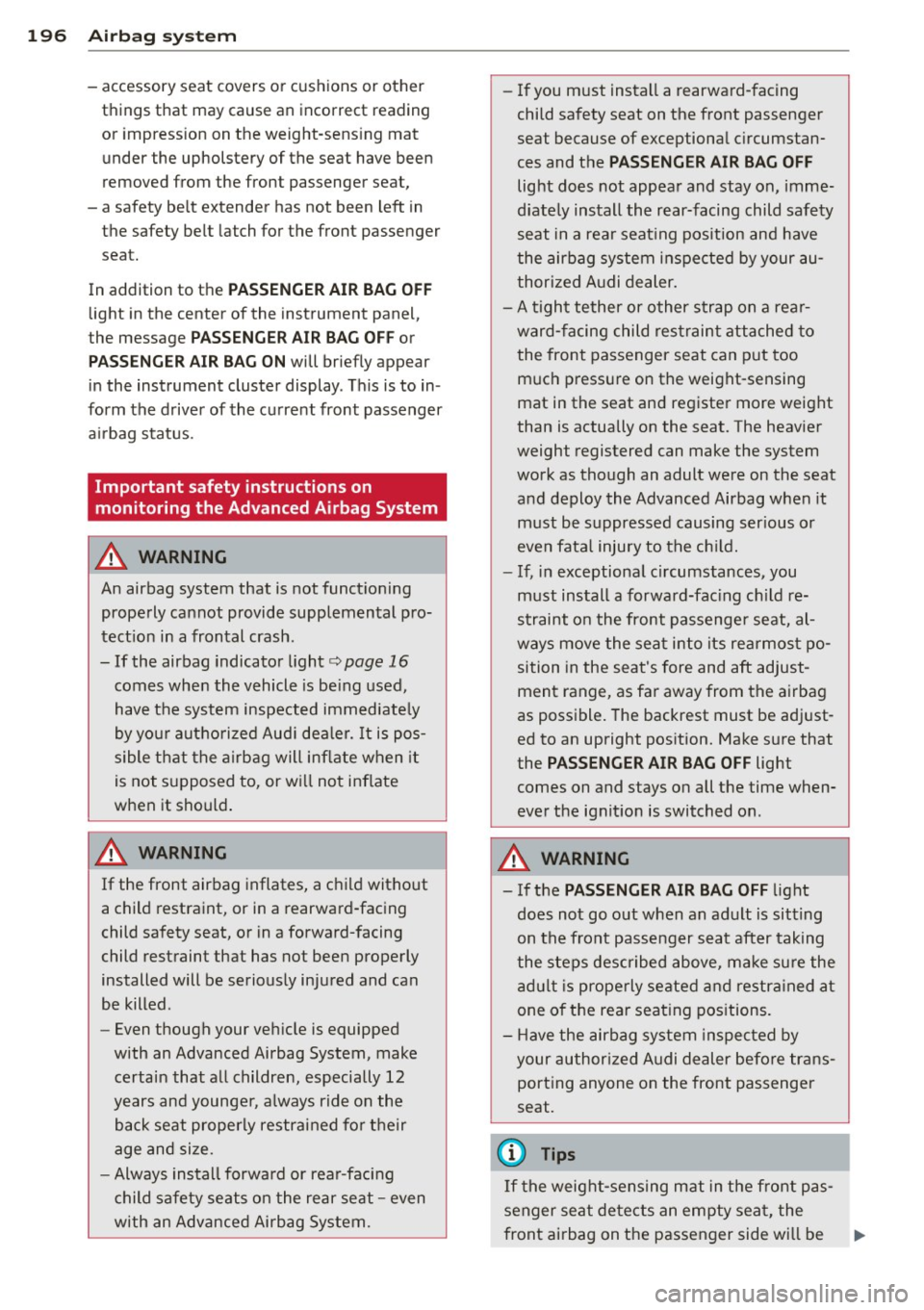
196 Airbag sys te m
- accessory seat covers or cushions or other
things that may cause an incorrect reading
or impress ion on the weight-sens ing mat
under the upholstery of the seat have been
removed from the front passenger seat,
- a safety belt extender has not been left in
the safety belt latch for the front passenger
seat.
In addition to the
PA SSENGER AIR B AG OFF
light in the center of the instrument panel,
the message
PASS ENGER AIR B AG O FF or
PASS ENGER AIR B AG O N will briefly appear
in the instrument cluster display . T his is to in
form the driver of the current front passenger
a irbag status .
Important safety instructions on
monitoring the Advanced Airbag System
_&. WARNING
An airbag system that is not functioning
prope rly cannot provide supplemental pro
tect ion in a frontal crash.
- If the airbag indicator light
c::> page 16
comes when the vehicle is be ing used,
have the system inspected immediately
by you r authorized Aud i dea ler.
It is pos
sible that the airbag will inflate when it
is not supposed to, or w ill not inflate
when it should .
_&. WARNING
If the front airbag inflates, a child witho ut
a child restraint, or in a rearward-facing
child safety seat, or in a forward-facing
child restraint that has not been properly
installed will be seriously injured and can
be killed .
- Even though your veh icle is equipped
with an Advanced Airbag System, make certain that all children, especially 12
years and younger, a lways ride on the
back seat properly restrained for their
age and size.
- Always install forwa rd or rear-facing
child safety seats on the rear seat -even
with an Advanced Airbag System. -
If you must install a rearward-facing
child safety seat on the front passenger
seat because of exceptional c ircumstan
ces and the
PA SS ENGER AIR BA G OFF
light does not appear and stay on, imme
diate ly install the rear-facing child safety
seat in a rear seat ing pos ition and have
the airbag system inspected by your au
thorized A udi dealer.
- A tight tether or other strap on a rear ward-facing child restraint attached to the front passenger seat can p ut too
m uch pressure on the weight-sensing
mat in the seat and register more weight
than is actually on the seat. The heavier
weight registered can make the system
work as though an adult were on the seat
and deploy the Advanced Airbag when it
must be suppressed causing ser ious or
even fata l injury to the ch ild.
- If, in exceptional circumstances, you
must install a forward-fac ing ch ild re
straint on the front passenger seat, al
ways move the seat into its rearmos t po
sition in the seat's fore and aft adjust
ment range, as far away from the airbag
as possible. The backrest must be adjust
ed to an upright position. Make sure that
the
PASSEN GER AIR BAG OFF light
comes on and stays on all the time when
ever the ignit ion is switched on .
_&. WARNING
r-
- If the PASSENGER AIR BAG OFF light
does not go out when an adult is sitting
on the front passenger seat after taking
the steps described above, make sure the
adu lt is properly seated and restra ined at
one of the rea r seat ing pos itions.
- Have the airbag system inspected by
your author ized Audi dealer befo re trans
port ing anyone on the front passenger
seat.
('D Tips
If t he weight-sensing mat in the front pas
senger seat de tects an empty seat, the
front airbag on the passenger side wi ll be
jll,,
Page 202 of 340
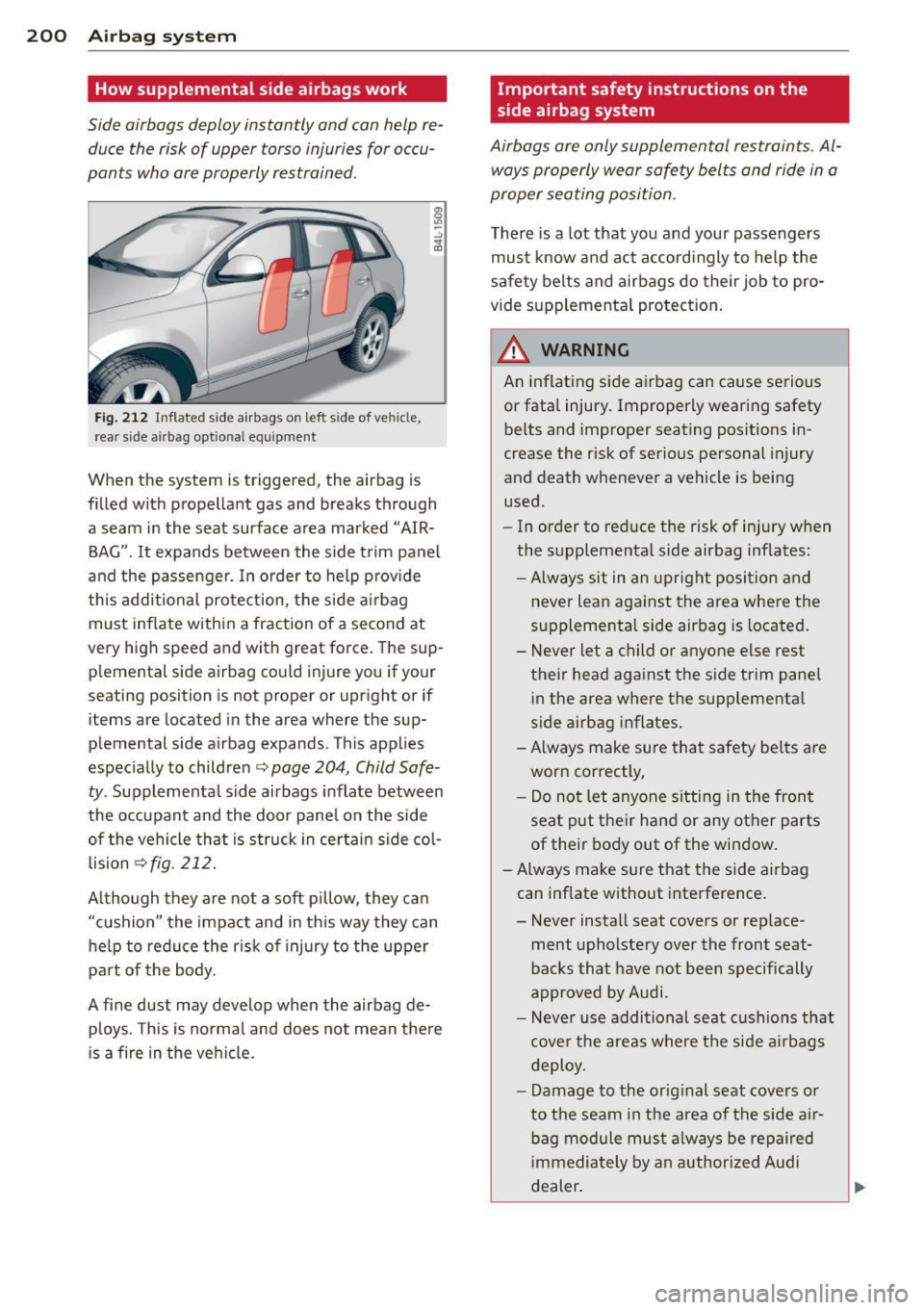
200 Airbag system
How supplemental side airbags work
Side airbags deploy instantly and con help re
duce the risk of upper torso injuries for occu
pants who ore properly restrained.
Fig. 212 Infl ated sid e airbags o n left side of vehicle,
r ea r sid e airbag optional equipment
ID
When the system is triggered, the airbag is
filled with propellant gas and breaks through
a seam in the seat surface area marked "AIR
BAG".
It expands between the side trim panel
and the passenger . In order to help provide
this additional protection, the side airbag must inflate within a fraction of a second at
very high speed and with great force. The sup
plemental side airbag could injure you if your
seating position is not proper or upright or if
items are located in the area where the sup
plemental side airbag expands . T hi s applies
especially to children
c::> page 204, Child Safe
ty .
Supplemental side airbags inflate between
the occupant and the door panel on the side of the vehicle that is struck in certain side col
lision
c::> fig . 212.
Although they are not a soft pillow, they can
"cushion" the impact and in this way they can
help to reduce the risk of injury to the upper
part of the body.
A fine dust may develop when the airbag de ploys. This is normal and does not mean there
is a fire in the vehicle.
Important safety instructions on the
side airbag system
Airbags ore only supplemental restraints. Al
ways properly wear safety belts and ride in a
proper seating position.
There is a lot that you and your passengers
must know and act accordingly to help the
safety belts and airbags do their job to pro
vide supplemental protection.
A WARNING
An inflating side airbag can cause serious
or fatal injury. Improperly wearing safety belts and improper seating positions in
crease the risk of serious personal injury
and death whenever a vehicle is being
used.
- In order to reduce the risk of injury when
the supplemental side airbag inflates:
- Always sit in an upright position and
never lean against the area where the
supplemental side airbag is located.
- Never let a child or anyone else rest
their head against the side trim panel
in the area where the supplemental
side airbag inflates.
-Always make sure that safety belts are worn correctly,
- Do not let anyone sitting in the front
seat put their hand or any other parts
of their body out of the window.
-Always make sure that the side airbag can inflate without interference.
- Never install seat covers or replace
ment upholstery over the front seat
backs that have not been specifically
approved by Audi.
- Never use additional seat cushions that
cover the areas where the side airbags
deploy.
- Damage to the original seat covers or
to the seam in the area of the side air
bag module must always be repaired
immediately by an authorized Audi
dealer.
Page 205 of 340
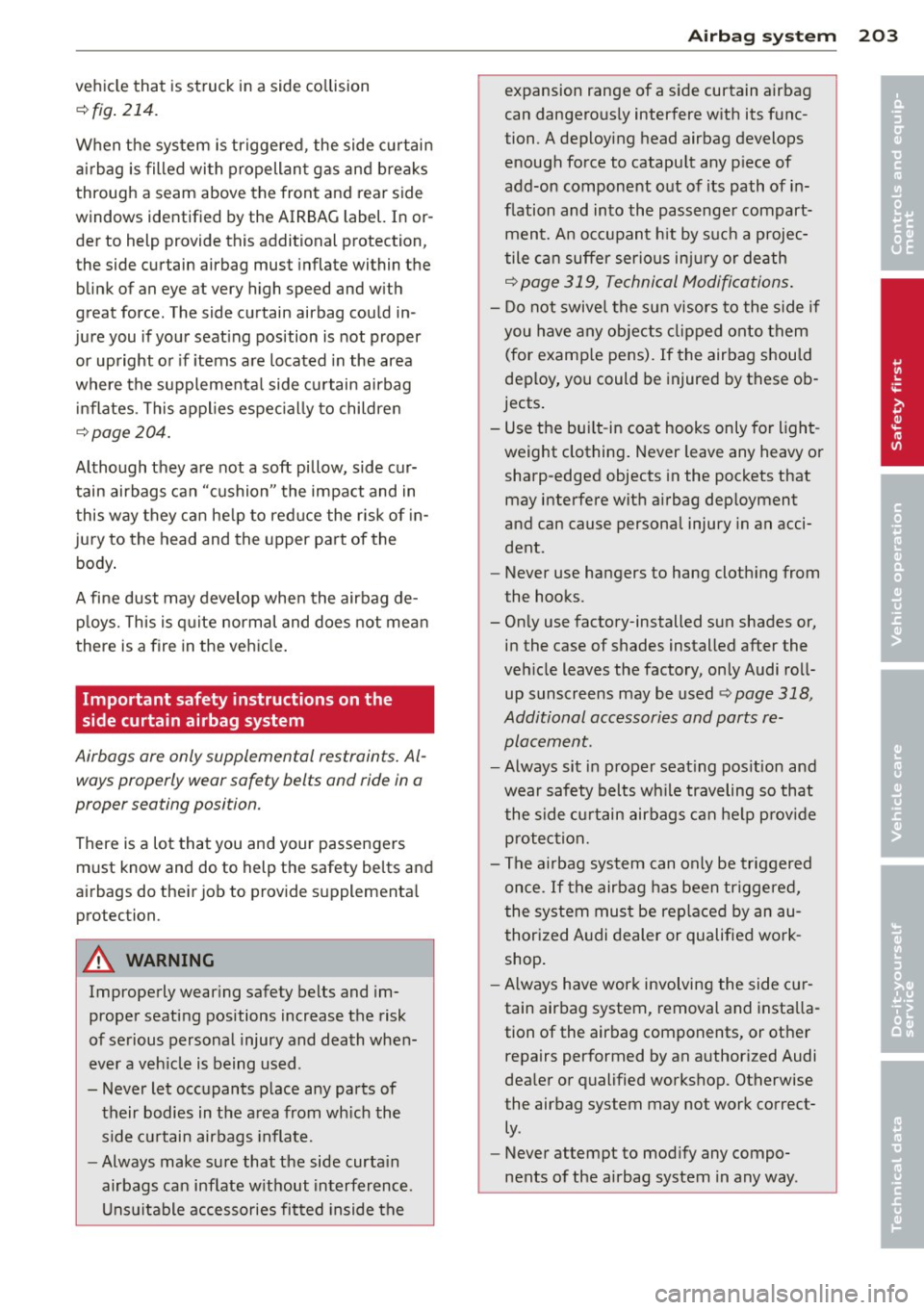
vehicle that is struck in a side collision
~fig. 214.
When the system is triggered , the side curtain
airbag is filled with propellant gas and breaks
through a seam above the front and rear side
windows identified by the AIRBAG label. In or
der to help provide this additional protection,
the side curtain airbag must inflate within the
blink of an eye at very high speed and with
great force. The side curtain airbag could in
jure you if your seating position is not proper
or upright or if items are located in the area
where the supplemental side curtain airbag
inflates . This applies especially to children
~ page 204.
Although they are not a soft pillow, side cur
tain airbags can "cushion" the impact and in
this way they can help to reduce the risk of in
jury to the head and the upper part of the
body.
A fine dust may develop when the airbag de
ploys. This is quite normal and does not mean
there is a fire in the vehicle.
Important safety instructions on the
side curtain airbag system
Airbags are only supplemental restraints. Al
ways properly wear safety belts and ride in a
proper seating position.
There is a lot that you and your passengers
must know and do to help the safety belts and
airbags do their job to provide supplemental
protection.
A WARNING
Improperly wearing safety belts and im
proper seating positions increase the risk
of serious personal injury and death when
ever a vehicle is being used.
- Never let occupants place any parts of
their bodies in the area from which the
side curtain airbags inflate.
-A lways make sure that the side curtain
airbags can inflate without interference.
Unsuitable accessories fitted inside the
Airbag system 203
expansion range of a side curtain airbag
can dangerously interfere with its func
tion. A deploying head airbag develops
enough force to catapult any piece of
add-on component out of its path of in
flation and into the passenger compart
ment. An occupant hit by such a projec
tile can suffer serious injury or death
~ page 319, Technical Modifications.
- Do not swivel the sun visors to the side if
you have any objects clipped onto them
(for example pens). If the airbag should
deploy, you could be injured by these ob
jects.
- Use the built-in coat hooks only for light
weight clothing. Never leave any heavy or sharp-edged objects in the pockets that
may interfere with airbag deployment
and can cause personal injury in an acci
dent.
- Never use hangers to hang clothing from
the hooks.
- Only use factory-installed sun shades or,
in the case of shades installed after the
vehicle leaves the factory, only Audi roll up sunscreens may be used~ page 318,
Additional accessories and parts re
placement.
- Always sit in proper seating position and
wear safety belts while traveling so that
the side curtain airbags can help provide
protection.
- The airbag system can only be triggered
once . If the airbag has been triggered,
the system must be replaced by an au
thorized Audi dealer or qualified work
shop.
-Always have work involving the side cur
tain airbag system, removal and installa
tion of the airbag components, or other
repairs performed by an authorized Audi
dealer or qualified workshop. Otherwise
the airbag system may not work correct
ly.
- Never attempt to modify any compo
nents of the airbag system in any way.
•
•
Page 206 of 340
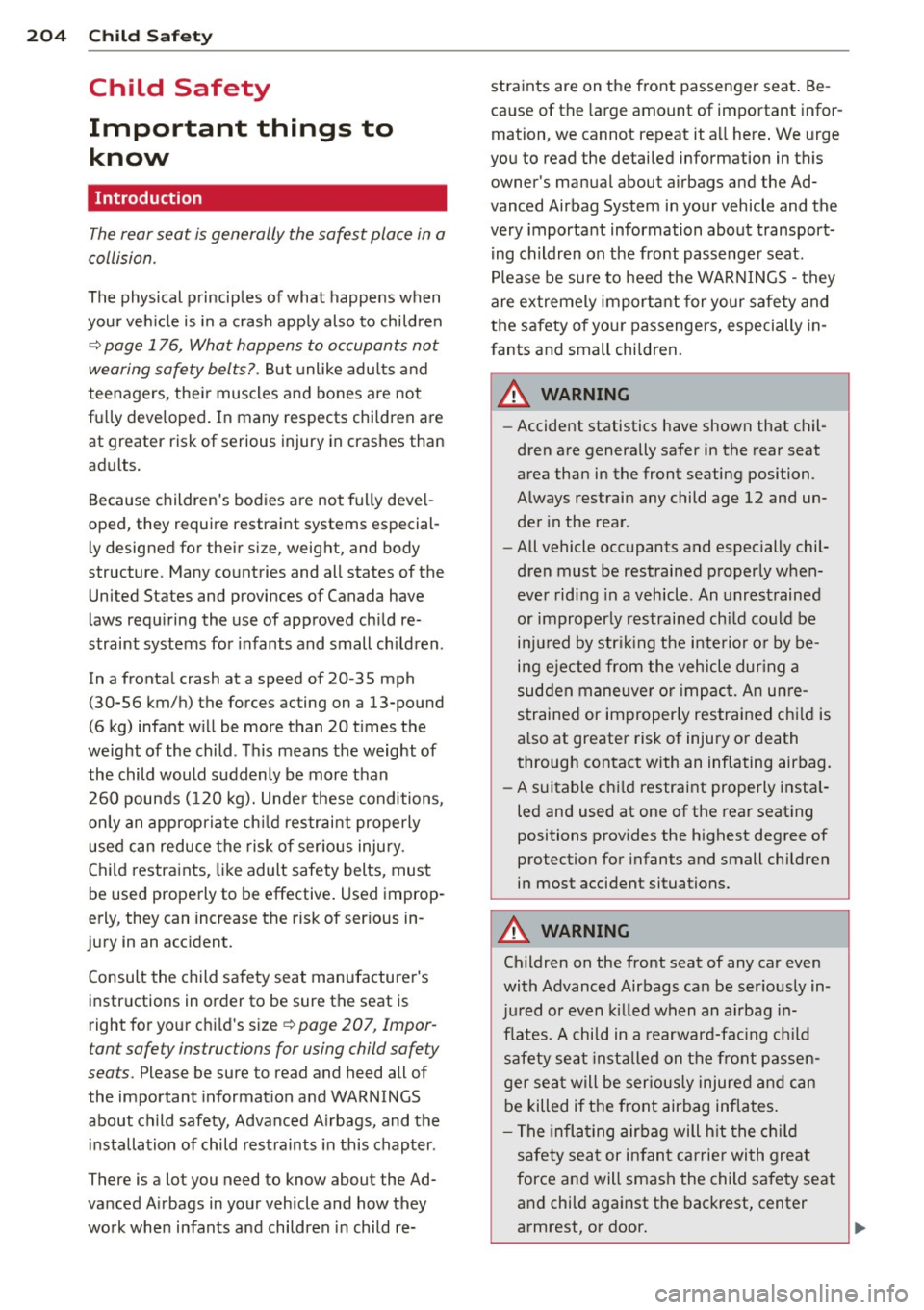
204 Child Saf ety
Child Safety
Important things to
know
Introduction
The rear seat is generally the safest place in a
collision.
The physical principles of what happens when
your ve hicle is in a crash app ly also to chi ldren
~ page 176, What happens to occupants not
wearing safety belts?.
But unlike adu lts and
teenagers, their muscles and bones are not
fu lly deve loped . In many respects chi ldren are
at greater risk of serious injury in crashes than
ad ults.
Because children's bod ies are not fully deve l
oped, they require restraint systems especial
l y designed for their size, weight, and body
structure. Many co untries and all states of the
United States and provinces of Canada have
laws requ iring the use of approved ch ild re
straint systems for infants and small ch ildren.
In a fronta l crash at a speed of 20 -35 mph
(30-56 km/h) the forces acting on a 13-po und
(6 kg) infant w ill be more than 20 t imes the
weight of the child. This means the weight of
the child would suddenly be more t han
260 pounds ( 120 kg). Unde r these conditions,
only an appropria te ch ild restrai nt properly
used c an reduce the risk of ser ious inju ry.
Chi ld restra ints, like adult safety belts, mus t
be used properly to be effective . Used improp
e rly, they can increase the risk of serious in
jury in an acc ident.
Consul t the child safety seat manufactu re r's
instr uctions in order to be sure the seat is
right fo r you r ch ild's size ~
page 207, Impor
tant safety instructions for using child safety
seats.
Please be sure to read and heed all of
the important informat ion and WARNINGS
about ch ild safety, Advanced A irbags, and the
i nstallation of child r estraints in this chapter .
There is a lot you need to know about the Ad
vanced A irbags in your vehicle and how they
wo rk whe n infants and children i n child re- stra
ints are on the front passenger seat . Be
ca use of the large amount of impo rtant infor
mation, we cannot repeat it a ll here . We urge
you to read the detai led information in t his
owner 's ma nual about airbags and the Ad
vanced Airbag System in your vehicle and the
very importa nt information about transport
ing ch ildr en on the fro nt passenge r seat.
Please be su re to heed the WAR NINGS -they
are extremely import ant for yo ur safe ty and
the safety o f your passenge rs, especially in
f ants and small children .
A WARNING
-Accident statistics have shown that chil
dren are generally sa fer in the rear seat
area than in the front seating position.
Always restrain any child age 12 and un
de r in the rear.
- All vehicle occupants and especially chil
d ren must be restrai ned properly when
eve r riding in a vehicle. An unrest rained
or improp erly restrained chi ld co uld be
in jur ed by str iking the i nterior o r by be
i n g ejected from the vehicle dur ing a
sud den maneuve r o r i mpac t. An un re
s traine d or improperly restrained ch ild is
also at greater risk of injury o r death
through contact with an inflating airbag.
- A suitable c hild restrai nt properly instal
led and used at one of the rear seat ing
positions prov ides the highest degree of
protection for infants and small children
in most accident situations.
A WARNING ,_
Children on the front seat of any car even
wi th Advanced Airbags can be ser iously in
j u red or even kil led when an airbag in
flates. A chi ld in a rearwa rd-fac ing c hild
safety seat in sta lled on t he fro nt passen
ger sea t will be ser iously injure d and ca n
b e killed if t he front airbag inflates .
- T he infla ting air bag will h it the chi ld
safety sea t or infan t carrie r wi th great
force and wi ll smash the child safe ty seat
an d chi ld aga inst the bac krest, center
armrest, or door.
II>-
Page 207 of 340
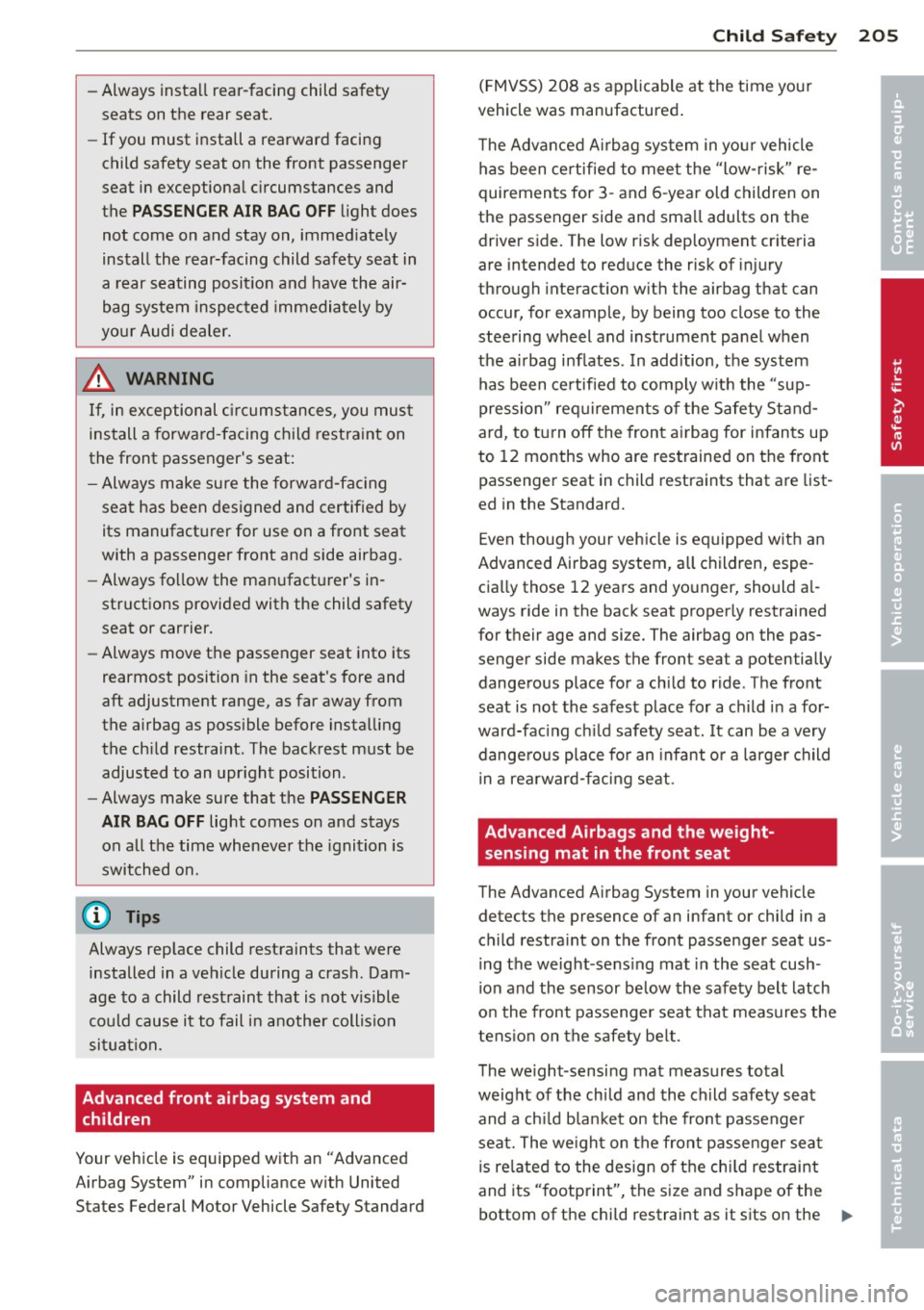
-Always install rear-facing child safety
seats on the rear seat.
- If you must install a rearward facing
child safety seat on the front passenger
seat in exceptional circumstances and
the
PASSENGER AIR BAG OFF light does
not come on and stay on, immediately
install the rear-facing child safety seat in
a rear seating position and have the air
bag system inspected immediately by
your Audi dealer.
_& WARNING
If, in exceptional circumstances, you must
install a forward-facing child restraint on
the front passenger's seat:
- Always make sure the forward-facing
seat has been designed and certified by its manufacturer for use on a front seat
with a passenger front and side airbag.
- Always follow the manufacturer's in
structions provided with the child safety
seat or carrier.
- Always move the passenger seat into its
rearmost position in the seat's fore and
aft adjustment range, as far away from
the airbag as possible before installing
the child restraint. The backrest must be
adjusted to an upright position .
- Always make sure that the
PASSENGER
AIR BAG OFF
light comes on and stays
on all the time whenever the ignition is
switched on.
(D Tips
Always replace child restraints that were
installed in a vehicle during a crash. Dam
age to a child restraint that is not visible
could cause it to fail in another collision
situation.
Advanced front airbag system and children
Your vehicle is equipped with an "Advanced
Airbag System" in compliance with United
States Federal Motor Vehicle Safety Standard
Child Safety 205
(FMVSS) 208 as applicable at the time your
vehicle was manufactured.
The Advanced Airbag system in your vehicle
has been certified to meet the "low-risk" re
quirements for 3- and 6-year old children on
the passenger side and small adults on the driver side. The low risk deployment criteria
are intended to reduce the risk of injury
through interaction with the airbag that can
occur, for example, by being too close to the
steering wheel and instrument panel when
the airbag inflates . In addition, the system
has been certified to comply with the "sup
pression" requirements of the Safety Stand
ard, to turn off the front airbag for infants up
to 12 months who are restrained on the front
passenger seat in child restraints that are list
ed in the Standard.
Even though your vehicle is equipped with an
Advanced Airbag system, all children, espe cially those 12 years and younger, should al
ways ride in the back seat properly restrained
for their age and size. The airbag on the pas
senger side makes the front seat a potentially dangerous place for a child to ride . The front
seat is not the safest place for a child in a for
ward-facing child safety seat. It can be a very
dangerous place for an infant or a larger child
in a rearward-facing seat .
Advanced Airbags and the weight
sensing mat in the front seat
The Advanced Airbag System in your vehicle
detects the presence of an infant or child in a
child restraint on the front passenger seat us
ing the weight -sensing mat in the seat cush
ion and the sensor below the safety belt latch
on the front passenger seat that measures the
tension on the safety belt.
The weight -sensing mat measures total
weight of the child and the child safety seat
and a child blanket on the front passenger seat. The weight on the front passenger seat
is related to the design of the child restraint
and its "footprint", the size and shape of the
bottom of the child restraint as it sits on the ..,.
•
•
Page 208 of 340
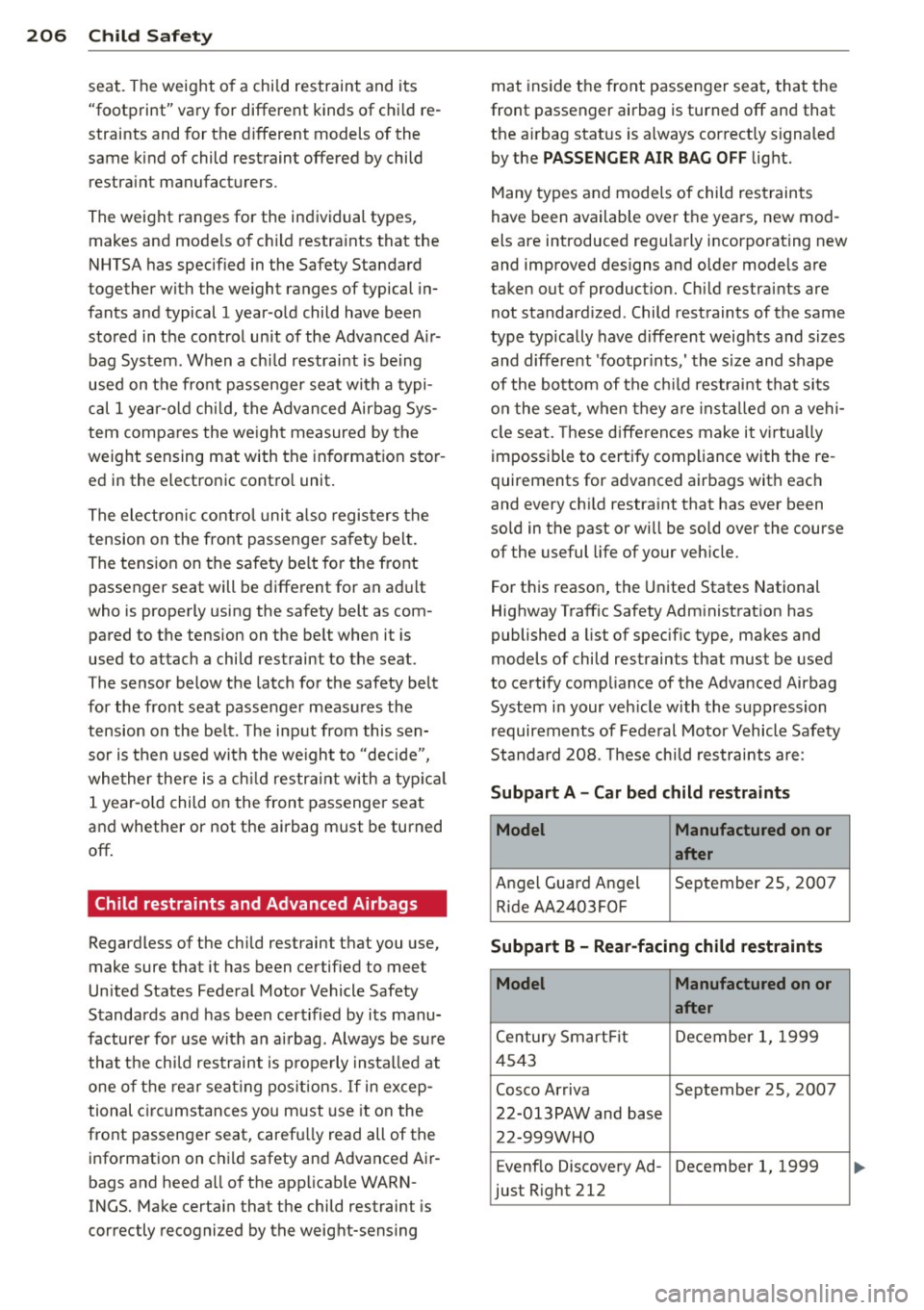
206 Child Saf ety
seat. The weight of a child restraint and its
"footprint" vary for different kinds of chi ld re
straints and for the d ifferent models of the
same kind of child restraint offered by child
restraint manufacturers .
The weight ranges for the individual types, makes and mode ls of ch ild restra ints that the
NHTSA has specified in the Safety Standard
together with the weight ranges of typical in
fants and typical 1 year-old child have been
stored in the control unit of the Advanced A ir
bag System. When a ch ild restrai nt is being
used on the front passenger seat with a typi
cal 1 yea r-old chi ld, the Advanced Airbag Sys
tem compares the weight measured by the
weight sensing mat with the information stor
ed in the electronic contro l unit.
The electron ic cont rol unit a lso registers the
tension on the front passenger safety belt.
The tension on the safety be lt for the front
passenger seat will be different for an adult
who is properly using the safety belt as com
pared to the tension on the belt when it is
used to attach a child restraint to the seat.
The sensor below the latch for the safety belt
for the front seat passenger measures the
tension on the be lt . T he input from this sen
sor is then used with the we ight to "dec ide",
whe ther there is a ch ild restraint w ith a typ ica l
1 year-o ld child on the front passenger seat
and whether or not the airbag must be turned
off .
Child restraints and Advanced Airbags
Regardless of the child restraint that you use,
make sure that it has been certified to meet
United States Federal Motor Vehicle Safety
Standards and has been certified by its manu
facturer for use w ith an airbag . Always be sure
that the ch ild restraint is p roperly insta lled at
one of the rear seat ing pos itions . If in excep
tional c ircu mstances you must use it on the
front passenger seat, carefu lly read all of the
info rmation on c hild safety and Advanced Air
bags and heed a ll of the applicable WARN
INGS. Make certain that the child restraint is
correctly recognized by the weig ht-sensing mat inside the front passenger seat, that the
front passenger airbag is turned off and that
the a irbag status is a lways correct ly signa led
by the
PAS SENGER AIR BAG OFF light.
Many types and models of child restraints
have been available over the years, new mod
els are introduced regu larly incorporating new
and improved des igns and o lder models are
taken out of product ion. Ch ild restraints are
not standard ized . Child restraints of the same
type typically have d ifferent weights and sizes
and different 'footpr ints,' the size and shape
of the bo ttom of the ch ild restra int that sits
o n the seat, when they are inst alled on a vehi
cle seat. These d ifferences make it v irtually
impossible to certify compliance with the re
quirements for advanced airbags with each
and every ch ild restraint that has ever been
sold in the past or will be sold over the course of the useful life of your veh icle.
For this reason, the United States National
Highway Traffic Safety Administrat ion has
published a list of spec ific type, makes and
models of child restraints that mus t be used
to certify comp liance of the Advanced Airbag
System i n your veh icle w ith the suppression
requirements of Federal Motor Vehicle Safety
Standard 208. These chi ld restraints are :
Subpart A - Car bed child restraints
Model Manufactured on or
after
Angel Guard A ngel September 25 , 200 7
R ide AA 2403FOF
Subpart B -Rear-facing child restraints
Model Manufactured on or
after
Century Smart Fit December 1, 1999
4543
Cosco Arriva September 25, 2007
22-013PAW and base 22-999WHO
E venflo Discovery Ad- December 1, 1999
just Right 212
Page 209 of 340
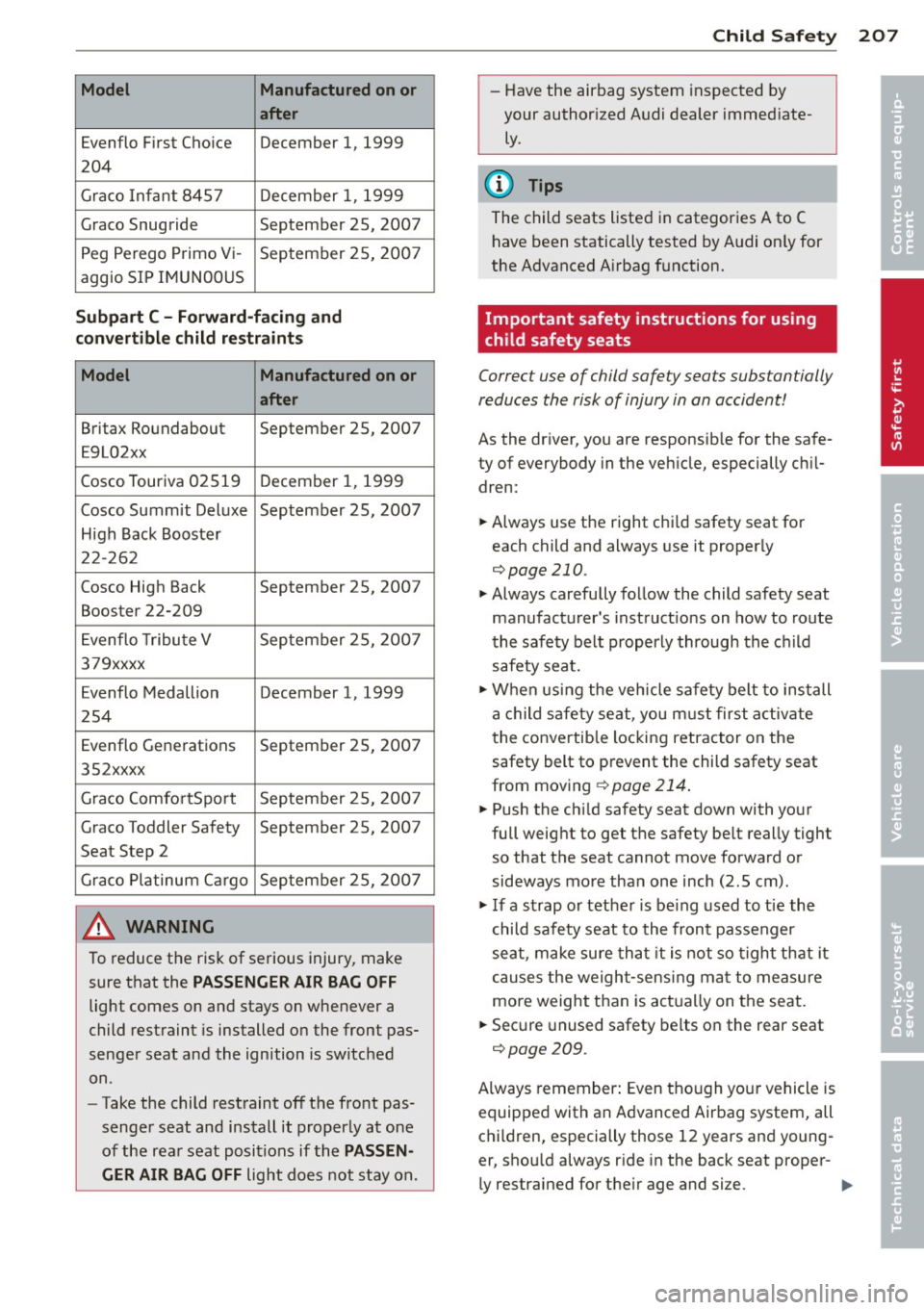
Model Manufactured on or
after
Evenflo First Choice December 1, 1999
204
Graco Infant 8457 December 1, 1999
Graco Snugride September 25, 2007
Peg Perego Primo Vi- September 25, 2007
aggio SIP IMUN00US
Subpart C - Forward-facing and
convertible child restraints
Model Manufactured on or
after
Britax Roundabout September 25, 2007
E9L02xx
Cosco Touriva 02519 December 1, 1999
Cosco Summit Deluxe September 25, 2007
H igh Back Booster
22-262
Cosco High Back September 25, 2007
Booster 22-209
Evenflo Tribute V September 25, 2007
379xxxx
Evenflo Medallion December 1, 1999
254
Evenflo Generations September 25, 2007
352xxxx
Graco Comfo rtSport September 25, 2007
Graco Toddler Safety September 25, 2007
Seat Step 2
Graco Platinum Cargo September 25, 2007
A WARNING
To reduce the risk of serious injury, make
sure that the
PASSENGER AIR BAG OFF
light comes on and stays on whenever a
child restraint is installed on the front pas
senger seat and the ignition is switched
on.
- Take the child restraint off the front pas
senger seat and install it properly at one
of the rear seat positions if the
PASSEN
GER AIR BAG OFF
light does not stay on.
Child Safety 207
-Have the airbag system inspected by
your author ized Audi dealer immed iate
ly.
@ Tips
The child seats listed in categories A to C
have been statically tested by Audi on ly for
the Advanced Airbag function.
Important safety instructions for using
child safety seats
Correct use of child safety seats substantially
reduces the risk of injury in an accident!
As the driver, you are responsib le for the safe
ty of everybody in the veh icle, especially ch il
dren:
... Always use the right chi ld safety seat for
each child and always use it properly
¢page 210.
... Always carefully follow the child safety seat
manufacturer's instruct ions on how to route
the safety belt properly through the child
safety sea t .
... When using the vehicle safety belt to install
a child safety seat, you must first activate
t he convertible locking retractor on the
safety belt to prevent the child safety seat
from moving
¢ page 214.
... Push the ch ild safety seat down with yo ur
full weight to get the safety belt really tight
so that the seat cannot move forward or
sideways more than one inch (2 .5 cm) .
... If a strap or tether is be ing used to tie the
child safety seat to the front passenger
seat, make sure that it is not so tight that it
causes the weight-sens ing mat to measure
more weight than is actually on the seat.
... Secure unused safety belts on the rear seat
¢page 209.
Always remember: Even though your vehicle is
equipped with an Advanced Airbag system, all
c hild ren, especially those 12 years and young
er, shou ld always r ide in the back seat proper-
ly restrained for the ir age and size. ..,. •
•
Page 210 of 340
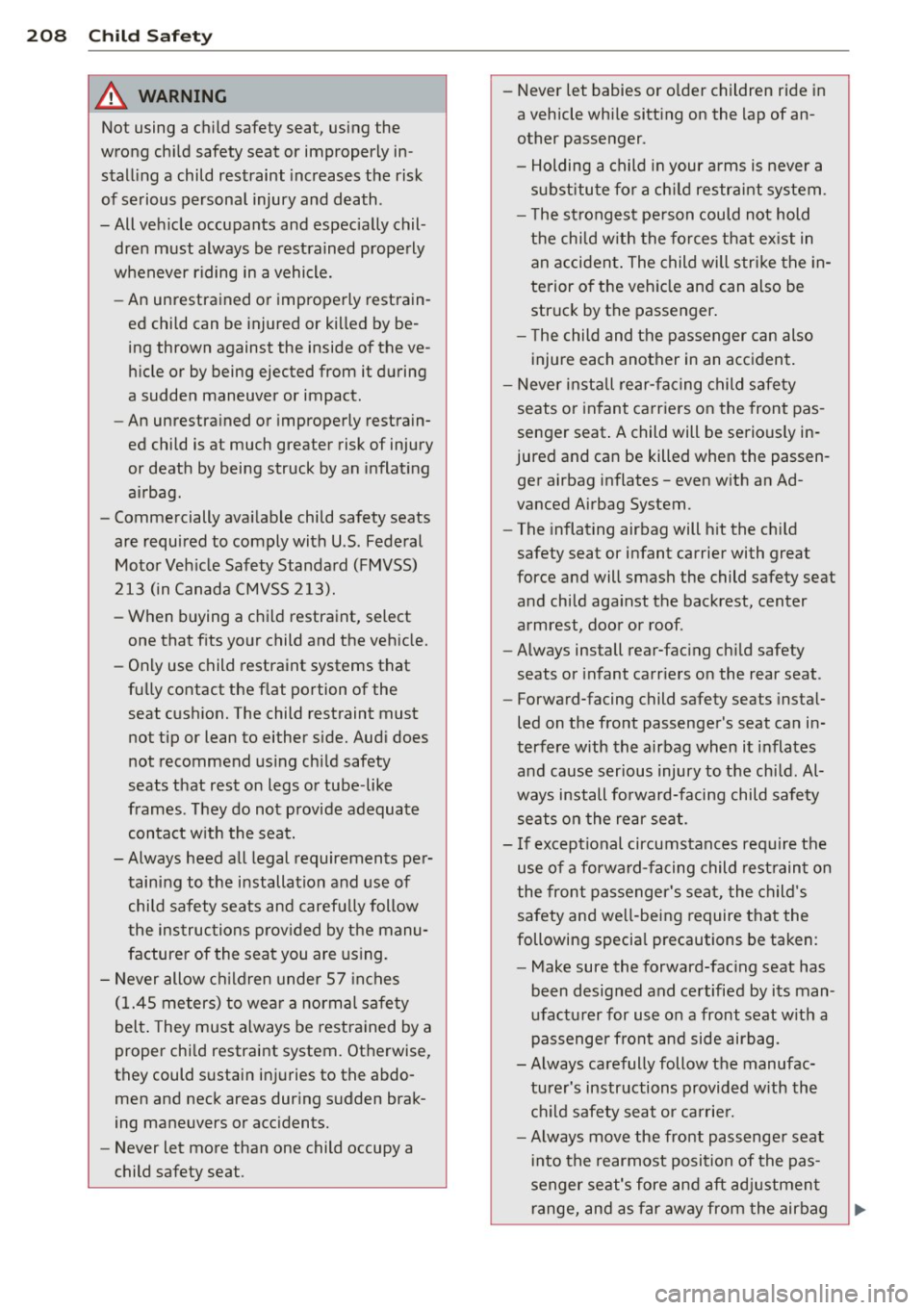
208 Child Safety
&_ WARNING
Not using a child safety seat, using the
wrong child safety seat or improperly in
stalling a child restraint increases the risk
of serious personal injury and death .
-All vehicle occupants and especially chil
dren must always be restrained properly
whenever riding in a vehicle.
-
- An unrestrained or improperly restrain
ed child can be injured or killed by be
ing thrown against the inside of the ve
hicle or by being ejected from it during
a sudden maneuver or impact .
- An unrestrained or improperly restrain
ed child is at much greater risk of injury
or death by being struck by an inflating
airbag.
- Commercially available child safety seats
are required to comply with U.S. Federal
Motor Vehicle Safety Standard (FMVSS)
213 (in Canada CMVSS 213).
- When buying a child restraint, select
one that fits your child and the vehicle.
- Only use child restraint systems that
fully contact the flat portion of the
seat cushion. The child restraint must
not tip or lean to either side. Audi does
not recommend using child safety
seats that rest on legs or tube -like
frames . They do not provide adequate
contact with the seat.
-Always heed all legal requirements per
taining to the installation and use of
child safety seats and carefully follow
the instructions provided by the manu
facturer of the seat you are using.
- Never allow children under 57 inches
(1.45 meters) to wear a normal safety
belt. They must always be restrained by a
proper child restraint system. Otherwise,
they could sustain injuries to the abdo
men and neck areas during sudden brak
ing maneuvers or accidents.
- Never let more than one child occupy a
child safety seat . -
Never let babies or older children ride in
a vehicle while sitting on the lap of an
other passenger .
- Holding a child in your arms is never a
substitute for a child restraint system .
- The strongest person could not hold
the child with the forces that exist in
an accident. The child will strike the in
terior of the vehicle and can also be
struck by the passenger.
- The child and the passenger can also
injure each another in an accident.
- Never install rear-facing child safety
seats or infant carriers on the front pas
senger seat. A child will be seriously in
jured and can be killed when the passen
ger airbag inflates -even with an Ad
vanced Airbag System .
- The inflating airbag will hit the child
safety seat or infant carrier with great
force and will smash the child safety seat
and child against the backrest, center
armrest, door or roof .
-Always install rear-facing child safety
seats or infant carriers on the rear seat .
- Forward-facing child safety seats instal
led on the front passenger's seat can in
terfere with the airbag when it inflates
and cause serious injury to the child. Al
ways install forward-facing child safety
seats on the rear seat .
- If exceptional circumstances require the
use of a forward-facing child restraint on
the front passenger's seat, the child's
safety and well-being require that the
following special precautions be taken :
- Make sure the forward-facing seat has
been designed and certified by its man
ufacturer for use on a front seat with a
passenger front and side airbag.
-Always carefully follow the manufac
turer's instructions provided with the child safety seat or carrier.
- Always move the front passenger seat
into the rearmost position of the pas
senger seat's fore and aft adjustment range, and as far away from the airbag
Page 211 of 340
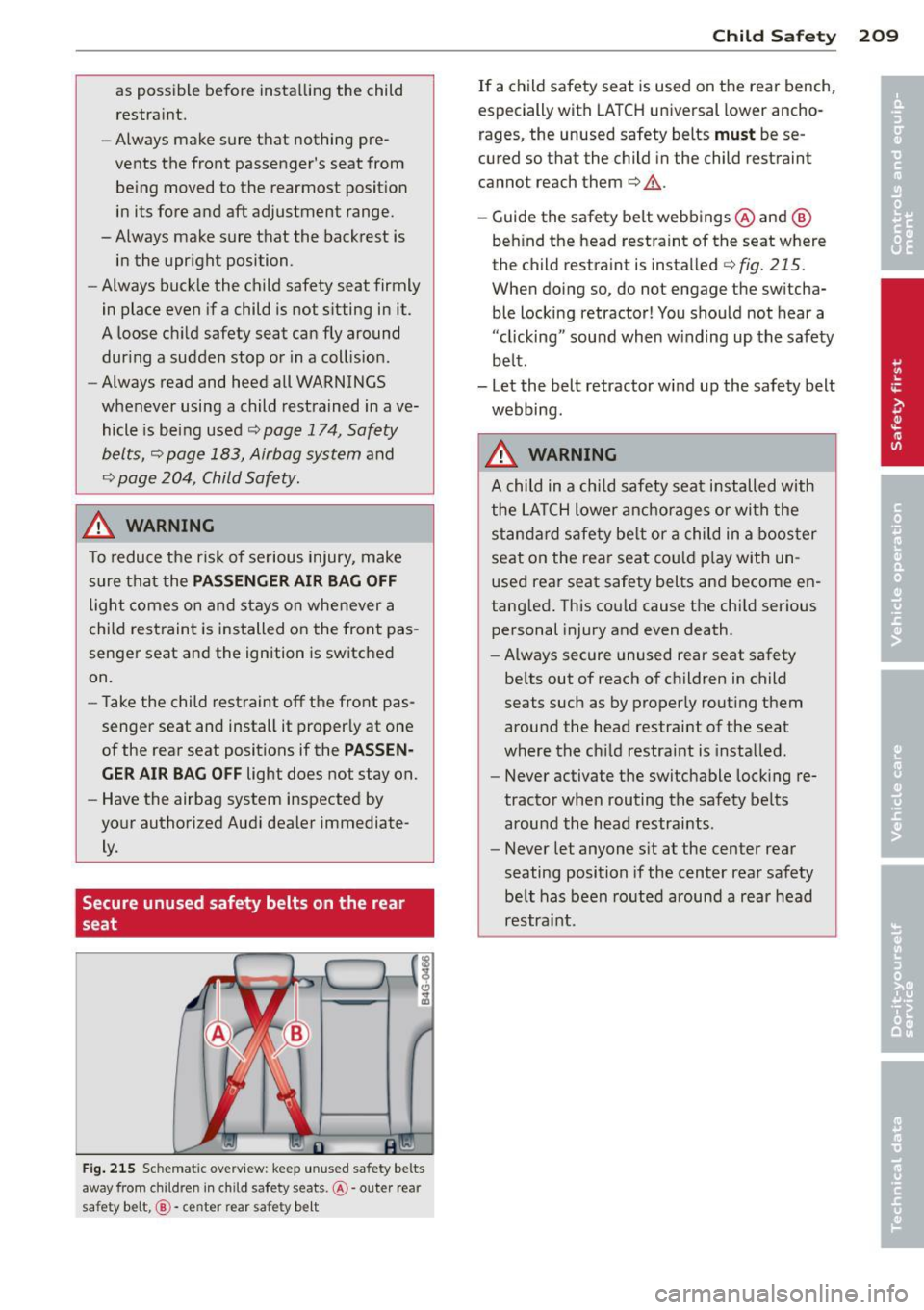
as possible before installing the child
restraint.
- Always make sure that nothing pre
vents the front passenger's seat from
be ing moved to the rearmost position
in its fore and aft adjustment range.
- Always make sure that the backrest is
in the upr ight position.
- Always buck le the child safety seat firmly
in place even if a child is not sitting in it.
A loose ch ild safety seat can fly around
dur ing a sudden stop or in a col lision .
- Always read and heed all WARNINGS
whenever using a child restrained in ave
hicle is being used¢
page 174, Safety
belts,¢ page 183, Airbag system
and
¢ page 204, Child Safety.
A WARNING
To reduce t he ris k of serious injury, make
sure that the
PASSENGER AIR BAG OFF
light comes on and stays on whenever a
child rest raint is installed on the front pas
senger seat and the ignition is switc hed
on.
- Take the child restraint off t he fro nt pas
senger seat and install it properly at one of the rear seat positions if the
PASSEN ·
GER AIR BAG OFF
light does not stay on.
- Have the airbag system inspected by
your authorized Aud i dealer immediate
ly.
Secure unused safety belts on the rear
seat
F ig. 21 5 Schematic overv iew : keep un used safety belts
away from children in child safety seats.@-oute r rear
safety belt,
@ -center rear safety belt
Child S afety 209
If a child safety seat is used on the rea r bench,
especially with LATCH universal lower ancho
rages, the unused safety belts
must be se
cured so that the child in the child restraint
cannot reach them¢&.
- Guide the safety belt webbings @and @
beh ind the head restraint of the seat where
the child restra int is insta lled ¢
fig. 215.
When doing so, do not engage the switcha
ble locking retracto r! You shou ld not hear a
"cl icking" sound when w inding up the safety
be lt .
- Let the belt retractor wind up the safety belt
webbing.
A WARNING
A child in a chi ld safety seat i nstalled with
the LA TCH lower ancho rages or with the
standard s afety be lt or a child in a boos ter
seat on the rea r seat co uld p lay with un
use d rea r seat safety belts and become en
tang led . This could cause t he chi ld ser ious
personal injury and even death.
- Always secure unused rear seat safety
be lts out of reach of children in child
seats such as by proper ly rout ing t hem
around the head restrai nt of the seat
where the ch ild restraint is installed.
- Never activate t he switchable l ock ing re
tracto r when routing the safety be lts
arou nd the head restraints.
- Never let anyone s it at the center rear
seating position if the center rea r safety
be lt has been routed around a rear head
restraint.
Page 212 of 340
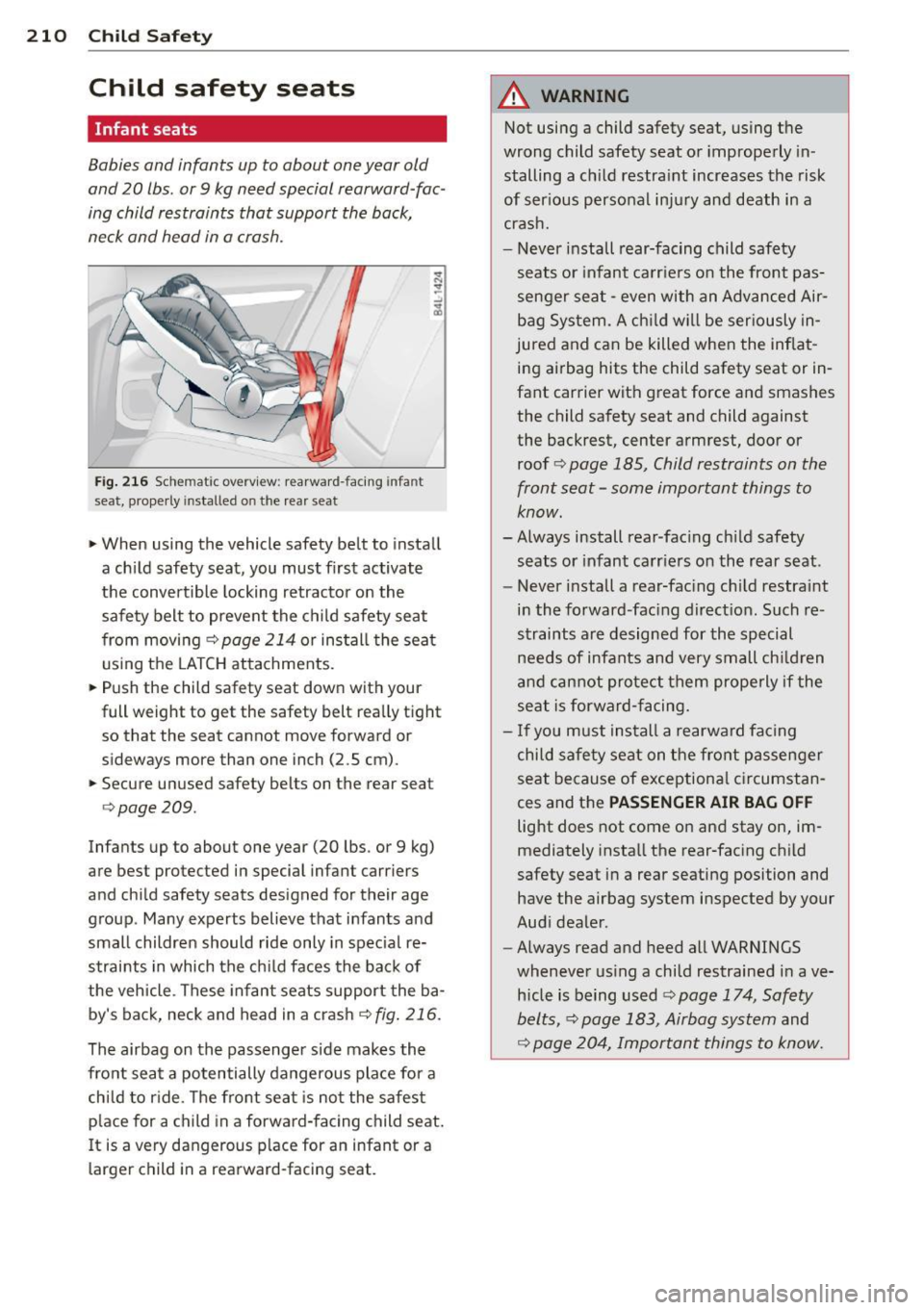
210 Child Safe ty
Child safety seats
Infant seats
Babies and infants up to about one year old
and 20 lbs. or 9 kg need special rearward-fac
ing child restraints that support the back,
neck and head in a crash.
-- /
Fig . 216 Sche matic overview: rearward- facing infant
seat, properly installed o n the rear seat
> When using the vehicle safety belt to install
a ch ild safety seat, you must first activate
the convertible locking retractor on the
safety belt to prevent the child safety seat
from moving ¢
page 214 or install the seat
using the LATCH attachments.
> Push the child safety seat down with your
full weight to get the safety belt rea lly tight
so that the seat cannot move forward or
sideways more than one inch (2.5 cm).
> Secure unused safety belts on the rear seat
¢page 209.
Infants up to about one year (20 lbs. or 9 kg)
are best protected in special infant carriers
and child safety seats designed for their age
group . Many experts believe that infants and
small children should ride only in spec ial re
straints in which the chi ld faces the back of
the vehicle . These infant seats support the ba
by's back, neck and head in a crash ¢
fig. 216.
The airbag on the passenger side makes the
fro nt seat a potentially dangerous place for a
child to r ide . The front seat is not the safest
p lace for a child in a forwa rd-facing child seat.
I t is a very dangerous p lace for an infant or a
larger child in a rearward-facing seat.
A WARNING
-Not using a child safety seat, using the
wrong child safety seat or improperly in
stalling a ch ild restra int increases the risk
of ser ious personal in jury and death in a
crash.
- Never install rear-facing child safety
seats or infant ca rr ie rs on the front pas
senger sea t -even with an Advanced Air
bag Sys tem. A c hild will be ser iously in
jured and can be killed whe n the inflat
ing ai rbag hits the child safety seat or in
fant carrier with great force and smashes the child safety seat and child against
the backrest, center armrest, door or
roof ¢
page 185, Child restraints on the
front seat -some important things to
know.
- Always install rear-facing ch ild safety
seats or infant ca rr ie rs on the rear seat .
- Never install a rear-fac ing ch ild restra int
in the forward-fac ing direct ion. Such re
straints are designed for the special needs of infants and very small ch ild ren
a nd cannot protect them prope rly if the
seat is forward- facing.
- If you m ust insta ll a rearwa rd fa cing
child safety seat on the fro nt passenger
seat because of exceptiona l circumstan
ces and the
PASSENGER AIR BAG OFF
light does not come o n and stay on, im
mediately insta ll the rear-fac ing child
safety seat in a rear seating position and
have the airbag system inspected by your
Aud i deale r.
- Always read and heed all WARNINGS
whenever us ing a child restrained in ave
h icle is being used¢
page 174 , Safety
belts, ~ page 183, Airbag system
and
c::> page 204, Important things to know.